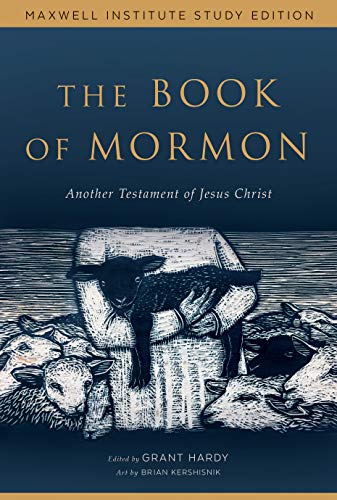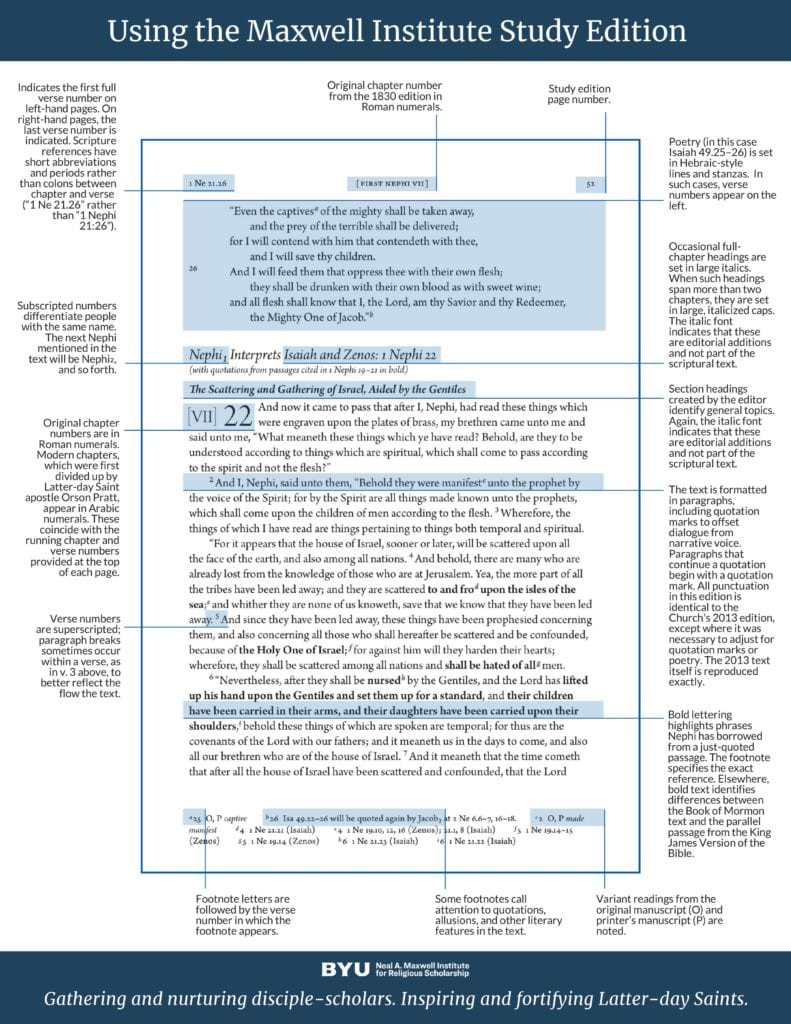
I’ve been reading and collecting the Book of Mormon my entire life in one form or another, from the illustrated “Book of Mormon for Beginning Readers” (or whatever it was called in the 1970s) to the official blue copy I handed out as a missionary, to Royal Skousen’s “Earliest Text.” I’ve also collected books written about the Book of Mormon, including much of Skousen’s Critical Text Project. I’ve appreciated being able to learn about the book and read it in these various formats particularly because I don’t usually like reading the same book more than once. This book edited by Grant Hardy gives a fresh new way to read it again, taking the official 2013 text and reformatting it to make for easier reading as well as to more easily identify various aspects, and also adding footnotes and other markers to point out changes gleaned from Skousen’s work, internal consistencies, and other interesting tidbits.
The book begins with the introduction from the 1981 edition “with minor modifications in 2013 (and the substitution of people for men in the third and next-to-last paragraphs),” (page vii) and then has the usual testimonies of three and eight witnesses, but then it also has the testimony of Emma Smith, taken from an interview by Joseph Smith III in 1879. In this, she mentions that Joseph did not have any manuscripts or books, what the plates felt like, that he did it “sitting with his face buried in his hat, with the [seer] stone in it,” (page ix) and that she did not believe her husband capable of composing it by himself.
This is followed by the Testimony of the Prophet Joseph Smith and Brief Explanation about the Book of Mormon, as you would find in a regular edition, although the Brief Explanation has an explanatory phrase inserted about the Plates of Ether. Then there is a Brief History of the Text, which is used as the editor’s introduction. In this, Hardy recounts the translation, printing, and subsequent editing and printing of the second edition.
He explains the work of Royal Skousen (“a professor of linguistics and English language at Brigham Young University, is the central figure in the academic analysis of the Book of Mormon text, including its origins, transmission, variants, and grammar”). He then describes what he has done in the book. “The footnotes here highlight instances in which earlier readings of the original and printer’s manuscripts may be more accurate, clearer, or more felicitous…. The notes here, however, are simplified, dispensing with Skousen’s indications of variants with a source, original and corrected readings in the manuscripts, spelling anomalies, and types of manuscript changes.” The original chapter divisions are indicated (“since these were apparently on the gold plates and thus were intended by ancient authors”), but the modern chapter and verse indicators are still included as well (page xvi).
His introduction ends with a statement that I believe sums up the purpose of the entire work: “The narrative complexity and coherence of the Book of Mormon — highlighted in this edition — offer some of the strongest evidences of its historicity and miraculous translation. As we learn to read the sacred text as carefully as possible, with detailed attention to language, structure, and historical context, its message of salvation through Jesus Christ will become more compelling and its lessons for life more clear” (page xvii). There is also a note that his royalties will be donated to the Humanitarian Aid Fund.
As examples of helpful explanations given in footnotes, footnote ‘a’ on the title page says, “Joseph Smith in 1838 said that the title page of the Book of Mormon is ‘not by any means a modern composition, either of mine, or of any other man who has lived or does live in this generation.’ For the 1840 edition, he added the name Moroni below the last line of the text as an indication of the original author, though the name was deleted in 1879.” Footnote ‘c’ says, “On the 1830 title page, Joseph Smith was identified as ‘author and proprietor’ in order to comply with copyright regulations. The preface to that same edition included Joseph’s assertion that he had translated ‘by the gift and power of God’ and that ‘the plates of which hath been spoken, were found in the township of Manchester, Ontario county, New York.’ The inscription ‘Translated by Joseph Smith, Junior’ has been on the title page of every edition since 1837” (page 1).
Here is a diagram of how a typical page is formatted, along with more footnote examples:
There is a lot of information packed into a typical page, and it is a little confusing at first. The section called “Using the Study Edition” (similar to the diagram above) will definitely come in handy until the reader becomes thoroughly familiar with the conventions used. It is at least much easier to decode than Skousen’s “Critical Text” volumes.
There are woodcuts by Brian Kershisnik at the beginning of each book, representing something from it. I particularly liked the one for Alma, with a seedling representing the lecture on faith growing from a seed. Third Nephi has two hands taking the resurrected Christ’s hand, showing the nail marks, while First Nephi has the Liahona.
At the back of the volume there is a collection of very helpful maps and charts, such as “Record Keepers in the Book of Mormon,” “Key Families in the Book of Mormon,” “Time Line of Nephite History,” and “Chronology of the Translation.” There are five pages of “Joseph Smith’s Statements on the Book of Mormon” followed by three and a half pages of “Stories of the Translation.” These provide insights into how Joseph Smith felt about the book, and how it was translated, some well known, and others not as much.
There is a section titled “General Notes” that talks about apparent anachronisms, the consistent internal chronology and coherence of the text, demographics, geography, language, the translation, and witnesses. These notes are very interesting, with the latest scholarship, as well as faith-promoting commentary: “This sacred record bears testimony of Jesus Christ from beginning to end, with an invitation to come unto Him and to see his Hand at work throughout history as He answers prayers, keeps covenants, and prepares a people for his coming” (page 623). A list of good books for further reading is also provided, with authors such as Brant Gardner, Terryl Givens, John Sorenson, and John Welch, among many others.
A section on “Literary Parallelism” is over eight pages long. It compares different types of parallelisms in the Bible with examples found in the Book of Mormon. “The writings of the prophets are much easier to understand when the English renditions of poetic passages are arranged so that they reflect the underlying poetic structure. Indeed, most modern translations of the Bible do this. It is easier to follow the prophets’ thoughts and arguments if we know where to expect repetition and where to look for new ideas. In this edition of the Book of Mormon, the lengthy excerpts from Isaiah that appear in 1 and 2 Nephi are presented in poetic form, but there are other sections of the Book of Mormon that also exhibit Hebrew-style parallelism, and these have similarly been arranged into lines and stanzas. While there are still many uncertainties about the Nephite language, reformed Egyptian (Mormon 9.32), and the nature of the translation, it is not surprising that when the Book of Mormon prophets wished to give particular emphasis to their message, they often employed the techniques of Hebrew poetry. In fact, characteristic biblical patterns of parallelism can be illustrated with examples from the Book of Mormon” (pages 625-626).
There is a helpful “Index of Names” based on the index in the 1981 Book of Mormon edition, with some differences, including variant spellings from the manuscripts. Finally, the “Reference Guide to the Book of Mormon” from the Doubleday edition is included, which also has some additions.
I have been enjoying reading this edition of the Book of Mormon. It gathers together many different resources to help bring out new insights, as well as pointing to things that are in the standard edition that may have been overlooked before. It has given me new appreciation for the internal consistency of the Book of Mormon, as well as a better understanding of its message. For someone who has read it many times already, it helps in seeing it with fresh eyes again.
The post Book Review: The Book of Mormon: Another Testament of Jesus Christ, Maxwell Institute Study Edition appeared first on FairMormon.
Continue reading at the original source →




